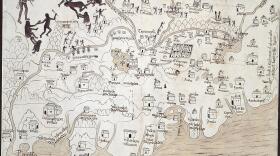Harvard scholar Davíd Carrasco discusses Chicano ties to Mesoamerica and a film project about his father's integration of a university basketball team.
-
Burns' six-part documentary uses voiceover, reenactors and drone footage to tell the story of America's founding. And it reminds viewers that the quest for a more perfect union is far from over.
-
A 100-year-old veteran who survived the Battle of Iwo Jima recounts his experience and the freedom he's enjoyed since the Allies won World War II.
-
A leader of the San Antonio Native American community is speaking out about the latest controversy at the Alamo over the firing of Alamo Trust President and CEO Kate Rogers and the removal of an Indigenous Peoples Day social media post.
-
When you think of Mount Rushmore, you picture four presidents carved in stone in the Black Hills of South Dakota. But part of that story began in San Antonio. Sculptor Gutzon Borglum began shaping his vision for the monument while working in San Antonio. As Mount Rushmore celebrates 100 years, we look back on the history and future of the landmark.
-
A new controversy at the Alamo over history, whose history gets told, and anti-woke politics has been reignited. Republican state leaders cracked down on the telling of the history of the Spanish mission. We hear from the American Indians in Texas at the Spanish Colonial Missions.
-
Christopher Columbus used to be considered a hero for "discovering America" But did he? Columbus has now become a more controversial figure. Five years ago San Antonio took down its Columbus statue. A new biography of Columbus takes a fresh look at the explorer – his life and afterlife – how our understanding of the man has changed.
-
Archeologist Jorge Luis García Ruiz documents the movement north of Spanish explorers in his book, Presidio: Soldiers of the King in New Mexico.
-
We think of the surrender of Robert E. Lee as the end of the Civil War, but the end really wasn’t clear at the time. The Galveston News reported Lee’s surrender as a positive development for the Confederacy and encouraged Texans to fight on. How did Lincoln’s peace take hold? How did a divided nation come together? Michael Vorenberg’s new book is Lincoln’s Peace: The Struggle to End the American Civil War.
-
George E. Hardy was the youngest Red Tail fighter pilot at 19 years old and completed 21 missions across Europe during World War II.
-
The city of San Antonio has donated the controversial Confederate memorial statue to SS American Memorial Foundation, based in Seguin.










